Dog Grooming 101
We all love our furry friends, but at some times of the year there’s more of them to love, and they leave the evidence all over the house. Man’s best friend has two shedding seasons, in spring from March to June, and then again in fall from September to November, meaning your pet is actively shedding for more than half the year.
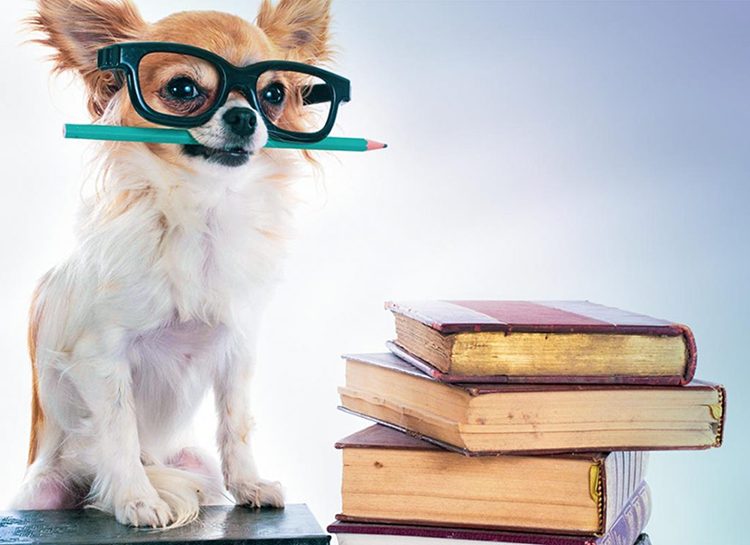
Breed and coat length play the biggest parts in determining how much hair your dog will shed, but good grooming habits can make shedding season bearable, even for the hairiest of breeds. Maintaining your dog’s coat is also important for other reasons, including keeping them healthy, helping you to check them over for any signs of injury or illness, and as a bonding activity to show your pupper you care.
Why groom your dog?
While many dogs love nothing more than a good snuggle, grooming them can be another matter entirely. Even shorthaired dogs need to be brushed on a regular basis, so it’s a good idea to get your dog used to being groomed and handled. Brushing helps remove loose hairs and dead skin, distributes oils evenly across their fur, and improves circulation to their coat and keeps them shiny and healthy.
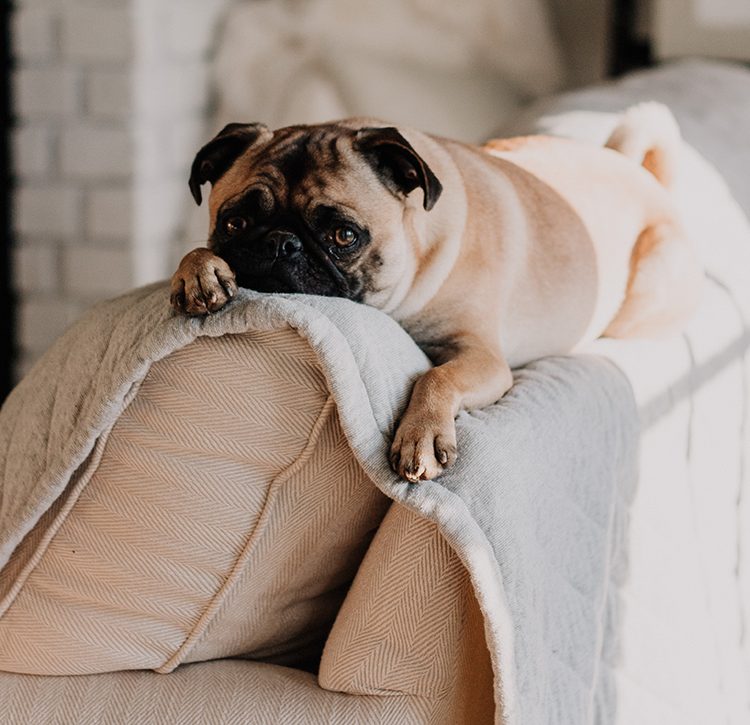
While grooming your pet, you can also check for overgrown nails, ear and eye infections, mites and ticks, and lumps and sores. Knowing what is and isn’t normal for your dog is an important factor in understanding their health and spotting something wrong at the earliest opportunity. If your dog has long hair, grooming is essential because it can get matted and tangled. Unresolved mats cause sores and open wounds on your dog’s skin, which can easily get infected. Regular grooming ensures that any at-risk areas are managed before they become problematic.
Training your dog for grooming
Grooming your dog isn’t the same as petting them, and nervous animals can be scared by your strange behavior or by brushes, clippers, and other tools. If you have a puppy, start training them to accept being groomed as soon as possible. It’s much easier to teach a young dog, but you can teach old dogs new tricks! All it takes is patience.
Some dogs take to grooming immediately and love the extra attention. There’s no harm in seeing how your dog will react to being brushed, but if they try to run away, tuck their tails and flatten their ears, or otherwise seem afraid, then stop immediately. The last thing you want to do is make grooming feel like a punishment or create a traumatic memory that will make it harder to groom your dog in the future.
If your pet is scared of being groomed, put away any tools and start by stroking them. Let them get used to being handled and make sure they allow you to touch their feet, legs, ears, and tail. It might take a while for skittish animals to come around, but with patience, lots of verbal reassurance, and maybe a few treats, even the most nervous dogs should allow you to stroke them without fear or complaint. Use your nails to mimic a grooming or brushing action through their fur so they get used to how it feels.
Once your dog is accustomed to being touched and handled, you can reintroduce a grooming brush. Don’t try to brush your pet immediately. Instead place the brush on the floor beside you and let the dog approach it in his own time. Discourage your dog from playing with or chewing the brush. You want him to be relaxed around it, rather than overly interested.
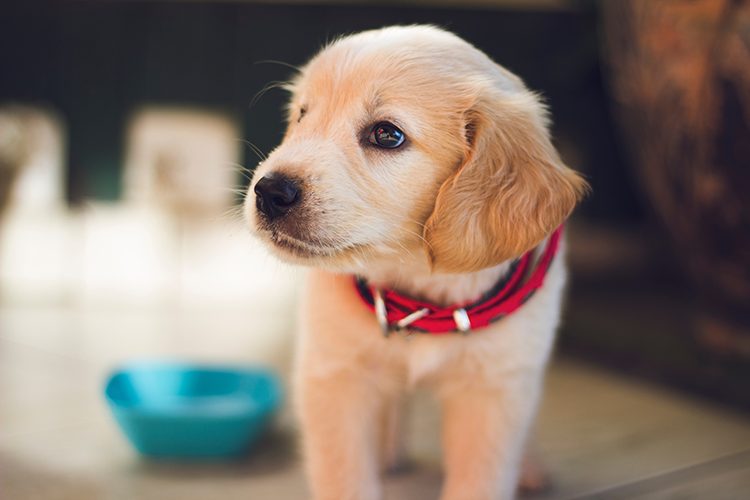
Before brushing your pet for the first time, let him sniff the brush as you approach with it. This will help him to relax and realize he knows what the brush is and isn’t scared. Start with a few light strokes and see how he reacts. Some dogs get over their fear of brushing very quickly, while others will take longer. If your dog is distressed, stop and try again at another time. Always reinforce good behavior with positive feedback. Use a calm, high-pitched voice and offer treats or a toy your dog loves as a reward.
Tip: If your dog is very food-orientated, treats can be a great way of training them. However to avoid your pup getting chubby, use small training treats or cut regular treats into smaller pieces, and use a clicker to slowly transfer your reward system away from food.
How to groom your dog
Once you’ve got your dog used to being brushed, you can concentrate on grooming them properly so they get the most benefit from it.
There are a number of different types of brushes available for pets. Which one you need depends on your dog’s age and coat. In general, puppies have much shorter, softer fur than adult dogs, as well as more sensitive skin, and you should use a soft-bristled brush to groom them. Puppies can be groomed from three weeks on, so you can begin grooming as soon as you get a new pet.
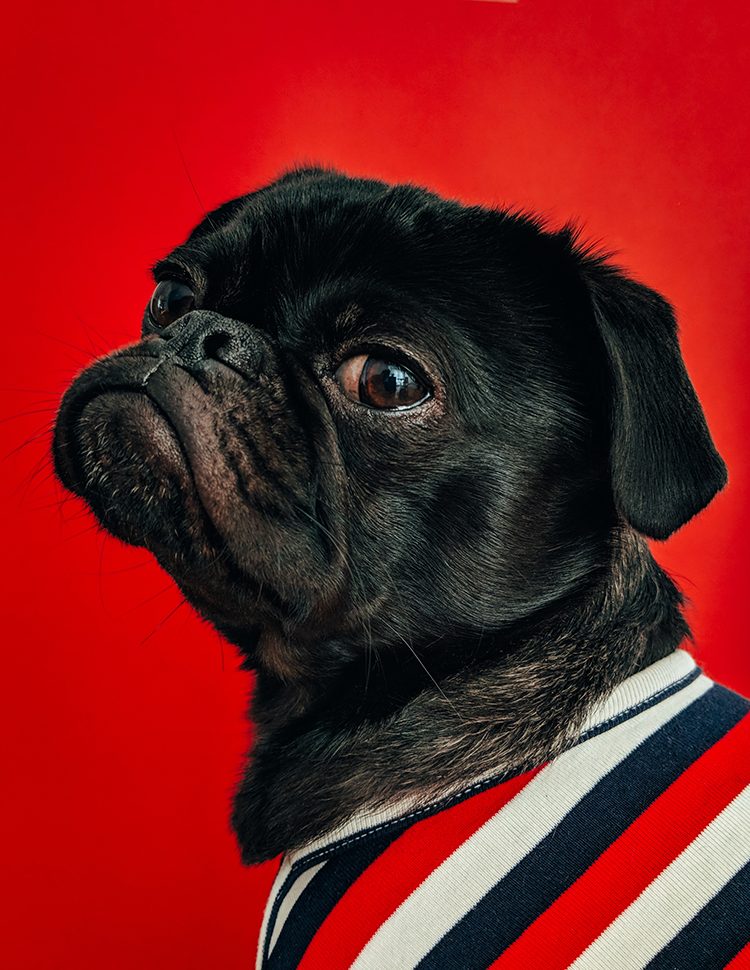
Adult dog coats often have two layers. The topcoat can have coarse or long fur depending on breed, while the undercoat tends to be very short and thick. The undercoat helps your dog regulate their temperature, but it sheds and can matt the same as their topcoat. Matted undercoats are common causes of smelly dogs and skin infections, so you want to make sure when you’re grooming your pet that you are reaching the undercoat with the brushes you use.
Types of Brush
Slicker brushes are large, wide brushes with lots of thin metal bristles. They can look a bit scary, but the bristles are specially angled so they should never rake your dog’s skin. They’re used for removing loose hair and dirt, and are great for dogs with curly hair or thick double coats.
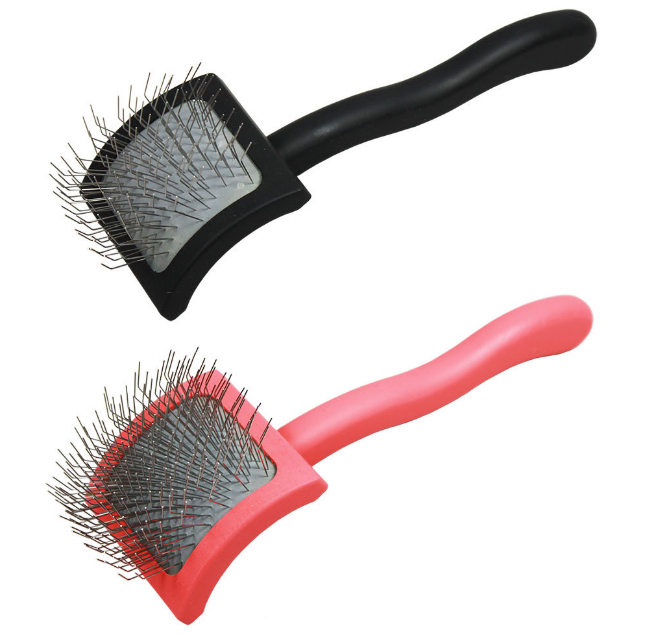
Bristle brushes look just like human hairbrushes. They come in a variety of sizes and bristle strengths so you can find a brush that suits your dog best. There are bristle brushes to suit almost any dog breed. A good rule-of-thumb is to match the bristles to your dog’s coat, choosing short, stiff bristles for shorthaired or coarse haired dogs, and long, soft bristles for longhaired animals.
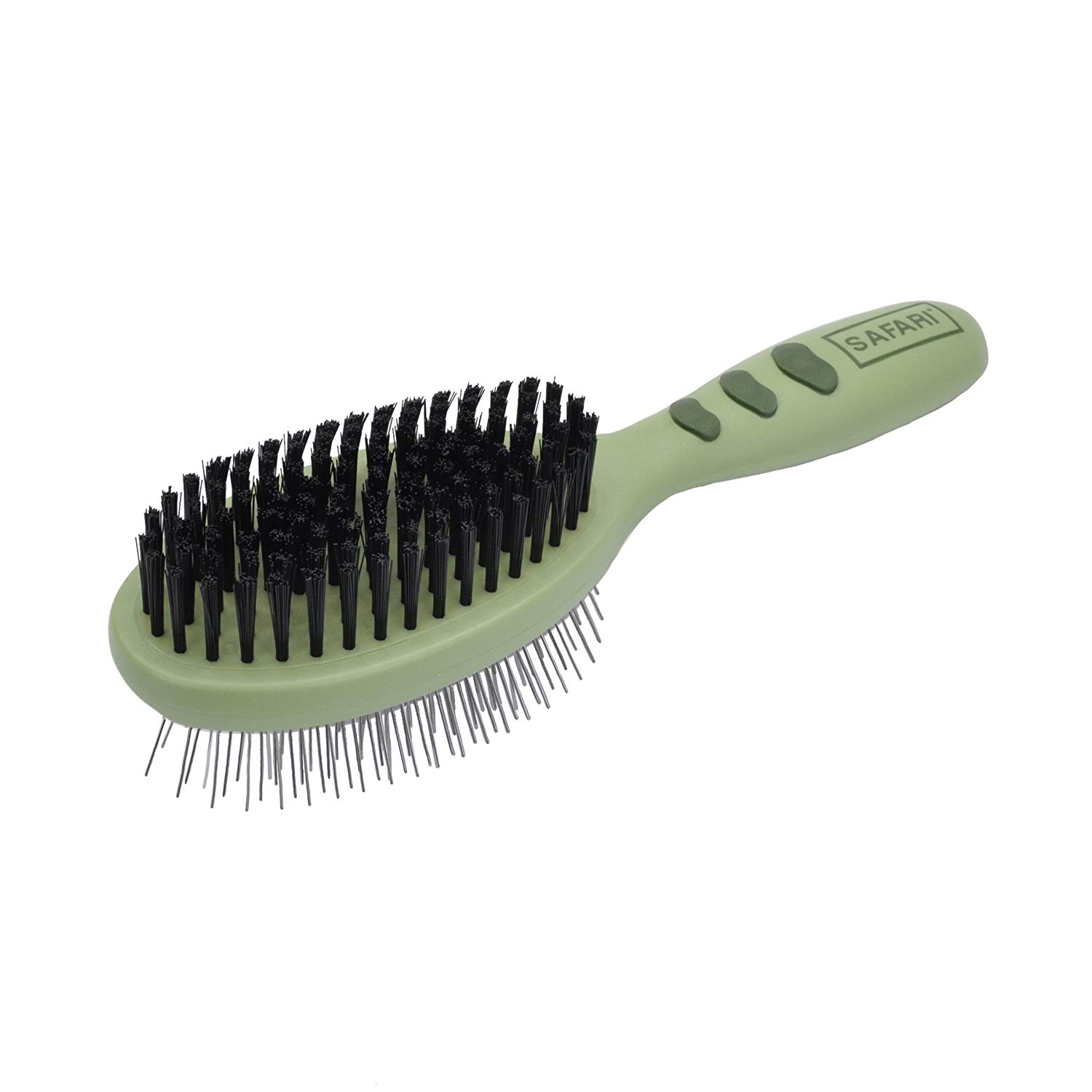
Pinhead brushes might also look familiarly like human hairbrushes. They’re usually oval shaped, long-handled brushes with widely spaced metal bristles, or “pins.” Frequently they have rubber or plastic tips to prevent the pins from scratching your dog’s skin. Pinhead brushes work great for medium-to-longhaired dogs as they’re good for detangling topcoats, but they don’t remove much loose hair so might not be the best brush for shedding season.
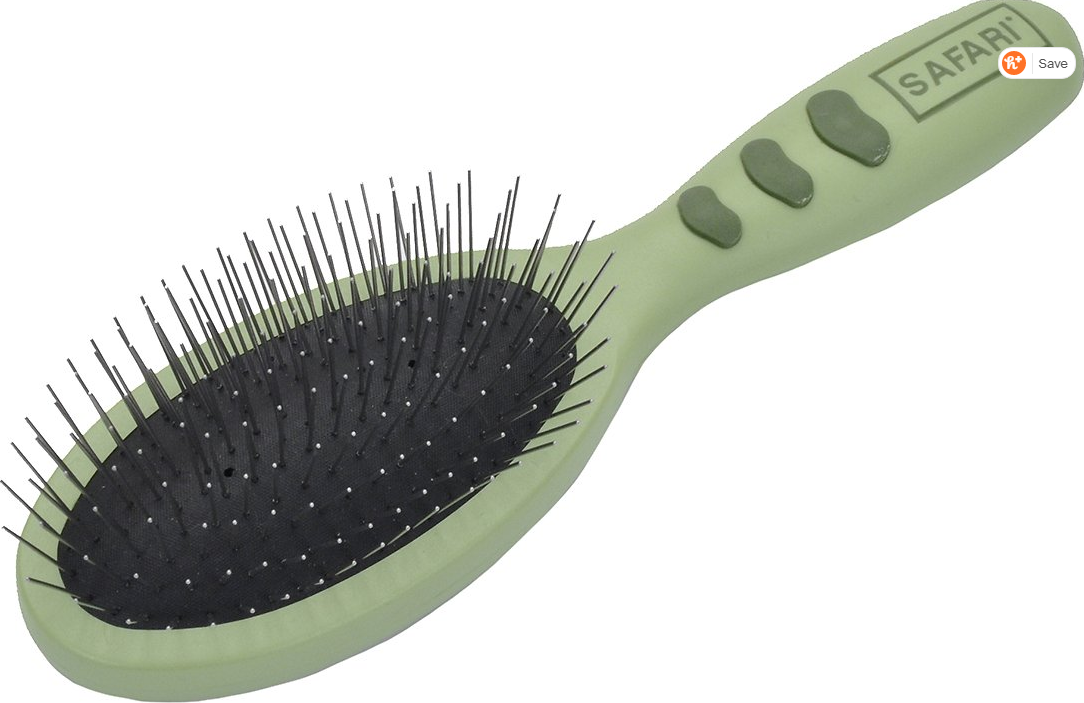
Undercoat rakes are great for getting through the top layer of your dog’s coat and detangling their undercoat, as well as lifting out loose fur. They have wide, rigid metal tines that can irritate your pet’s skin if they’re used too firmly, so be gentle and always match the length of the tines to your dog’s coat.
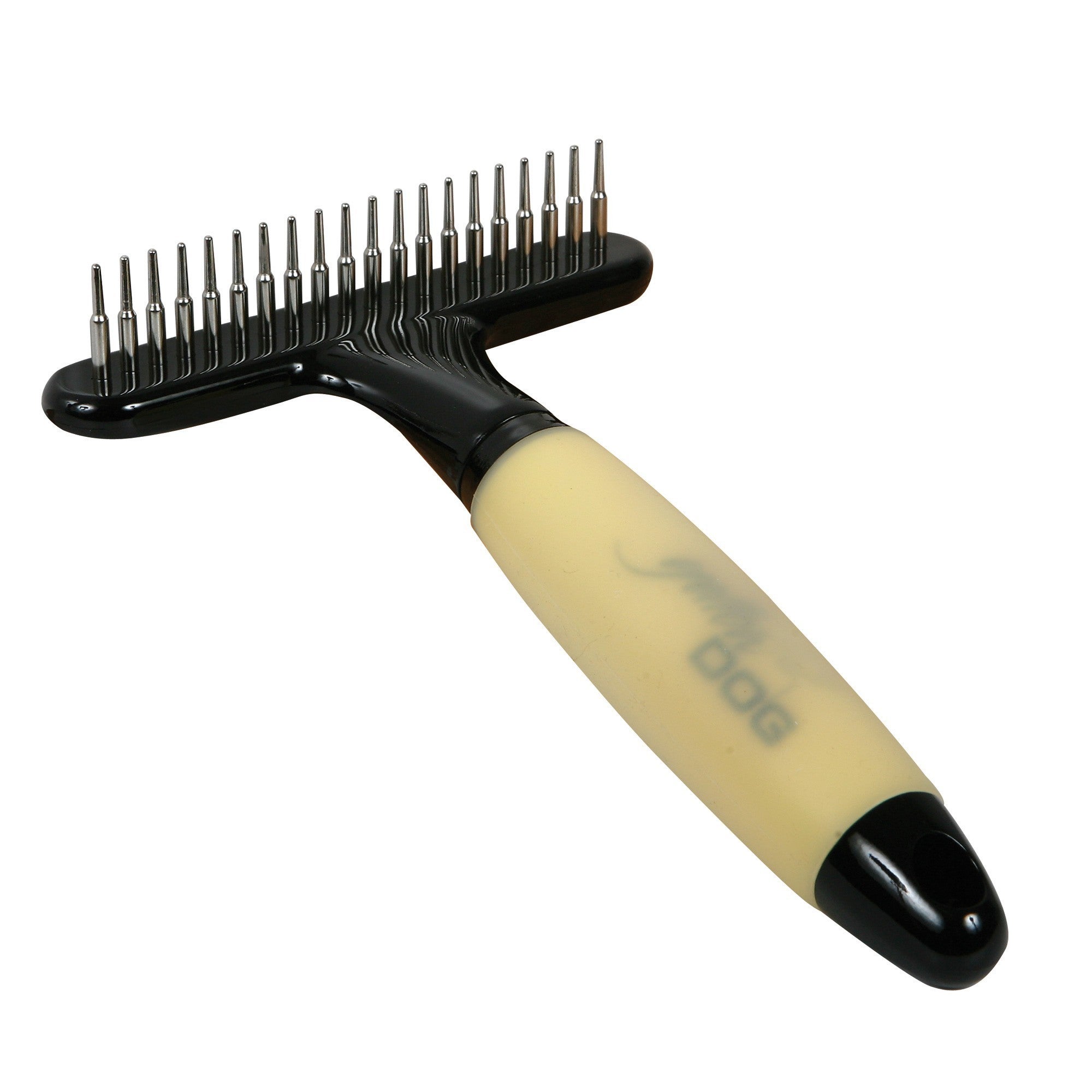
Wide-toothed combs are delicate tools specifically used to remove knots and tangles from longhaired dogs. They don’t make good general grooming tools but are useful if your pet is prone to matts.
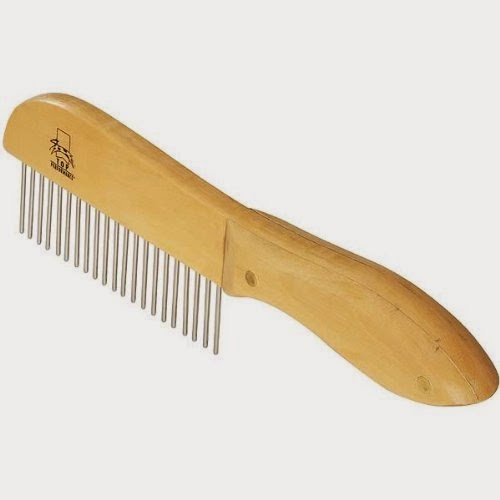
Stripping combs look more like torture devices than dog brushes, and should be used with caution, as they are very sharp. They look like long metal rakes with curved teeth, which are bladed to cut hair. Stripping combs are used for trimming the undercoat on particular breeds of dog that have thick, wiry hair, including schnauzers, wirehaired dachshunds, Irish wolfhounds, and several varieties of terrier. If you’ve never stripped your dog’s coat before, or aren’t sure if your pet needs their coat stripping, take them to a professional groomer for advice and instruction.
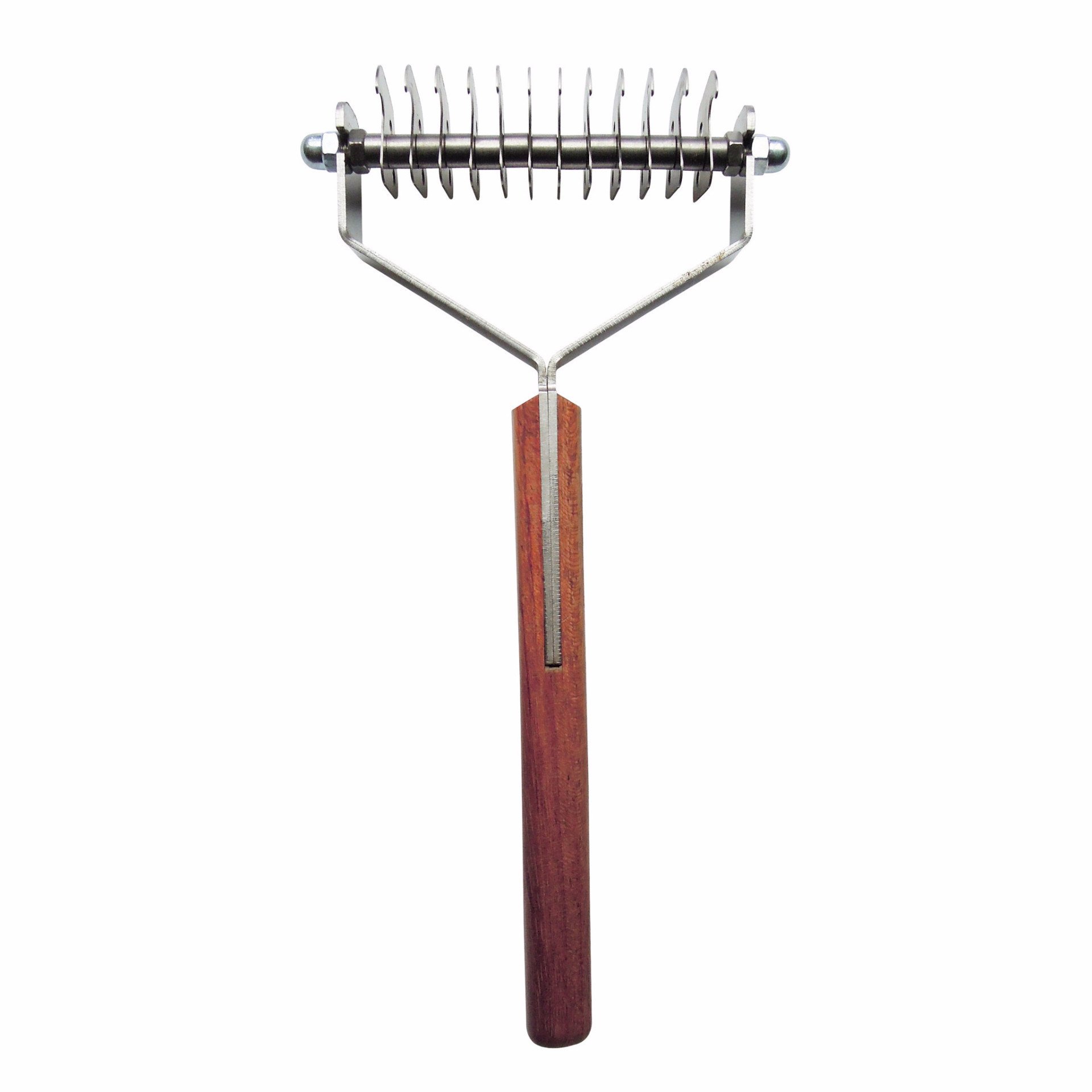
Rubber brushes and palm mitts are marketed as being easier, “brushless” alternatives to grooming your pet. They usually fit over your hand and work as you use a stroking motion. They can be good for training nervous dogs to accept being groomed, and for removing loose hair and dirt on short-coated dogs, but they won’t reach an undercoat or groom your pet properly.

Types of Coat
Shorthaired dogs, such as Dalmatians, Beagles, and Pugs, have the easiest coats to groom. A slicker or pinhead brush will tease out knots and matts, and a short, firm bristled brush will remove dirt and loose fur. If your shorthaired dog is shedding a lot, you can use a rubber brush or palm mitt to collect loose fur.
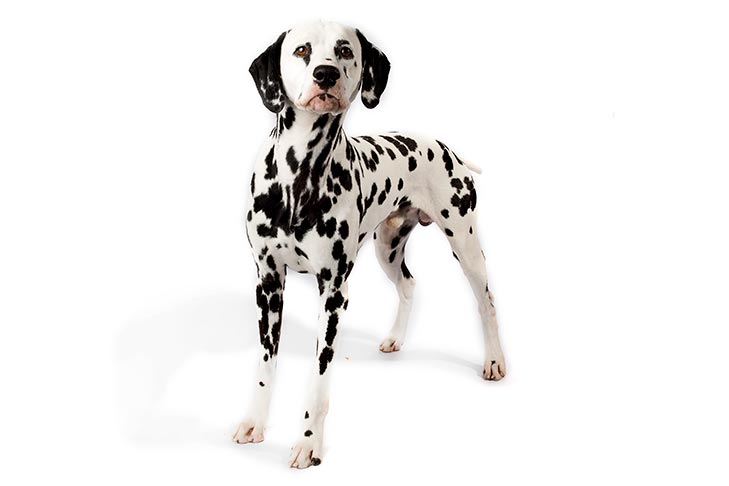
Longhaired dog breeds include Afghan hounds, Bernese mountain dogs, border collies, and King Charles spaniels. Maintaining a long coat can be harder and more time consuming because your dog’s hair can tangle and get matted the same as a human’s. Regular brushing with a slicker brush will help keep their coat in order. Tangles can be removed using a long-toothed comb, and an undercoat rake will remove the thickest fur as it’s shed.
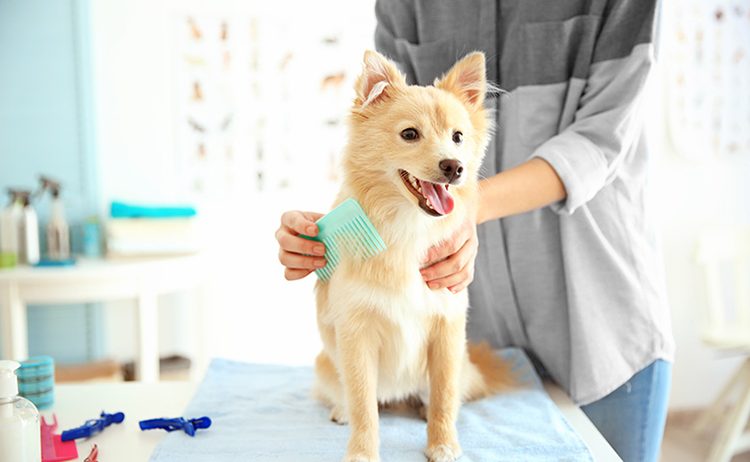
The texture of your dog’s coat will also affect how it’s groomed. Wirehaired dogs often need held shedding by having their coat stripped. You can do this by hand if you see tufts of fur sticking out from your dog’s coat. Give them a gentle pull, and if they come out easily then they’re ready for stripping. If your dog is shedding lots you can use a stripping comb, or have a professional take care of their coat for you.
Silky haired dogs sometimes lack an undercoat, or only have a very short, light coat under their long hair. This makes them more prone to matts and tangles, and their skin can be irritated by over-brushing. Use pinhead brushes with bristle protectors and don’t brush too firmly with these breeds. If your dog gets their hair very tangled, you can carefully trim it with scissors rather than hurt them by trying to work it loose.
Finally, curly haired dogs, such as poodles and bichon frises, can be difficult to brush because their fur is so thick and dense, but they shed much less than other breeds. Use slicker brushes to keep them groomed.
Why bathe your dog?
Regular grooming will take care of most of your dog’s cleaning needs, but the occasional bath will still be necessary. Give half a chance, dogs roll in all kinds of nasty things, and while they love the smell, people don’t. Some dogs have allergies and skin conditions that respond well to regular bathing, and if your dog has a particularly long or thick coat they may need bathing more often than shorthaired breeds.
You can over-wash your dog, so try to only bathe them when they’re smelly or matted. If you notice an unpleasant odor on your pet that bathing doesn’t cure, take them to the vet for a checkup. Often smells are the result of gross things they rolled in, but if your dog is clean and smelly it’s a sign there might be something wrong.
Training your dog for bathing
Most dogs aren’t thrilled at the idea of getting a bath. You can make bath time easier for both of you by training your dog to enjoy (or at least tolerate!) being bathed. While training is usually easier with puppies than older dogs, there’s no reason even a senior canine can’t learn that bath time isn’t scary. And remember that good behavior in the bath is about more than not running away: over excitable pups that splash and play also need to be trained to stand calmly and let you wash them.
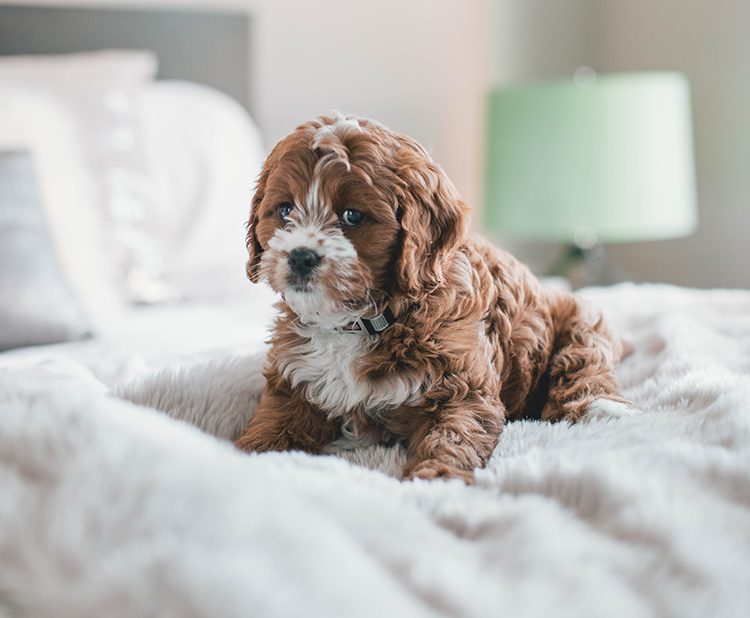
If your dog is already used to being groomed regularly, then they should be okay with similar handling in the bath. You biggest hurdle is therefore getting them used to being in the bath (or sink, or bowl) itself.
Think about the area where you intend to bathe your dog. Is it somewhere they’re used to being and feel comfortable? If you plan to put them in the tub or kitchen sink, it’s likely going to be a strange environment for them, as well as a new and potentially scary experience. Therefore start by getting them used to being in the bathing area.
Take them into the bathroom or lift them onto the kitchen counter to pet them and give them attention. Give them treats, or play with a favorite toy. Don’t try to coax them into the bath or sink immediately. Instead let them get used to being in a new part of the house and feeling comfortable there.
Once you’re ready to try putting them in the bath, consider the experience from their angle. The hard, slippery surface might seem like a bonus to you because they can’t get traction to jump out, but unstable footing makes many dogs anxious. Put down a rubber bath mat or line your sink with a towel to make a more stable base, and to protect your tub from scratches.
You can train your dog to “go to the mat” or put their food bowl on top of it so they get used to being on the mat or towel before you put it (and them!) into the bath. Once they get comfortable being near the bath, turn on the faucet and let them hear the running water. A bath tap or shower usually runs louder than other faucets, and the new sound might startle them. Let them get used to it in their own time, particularly if they’re skittish of water anyway.
How you ease your pet into the tub will depend a lot of their size and level of anxiety. Some dogs are big enough to get into the bath themselves with a little encouragement, whereas others will have to be picked up and put in. However you do it, try to go at your pet’s pace and if they’re showing signs of distress, take them out and try again the next day. Use a calm, high-pitched voice to speak to them and don’t shout or tell them off, even if they send all your shampoo and shower gel crashing in their scramble to get out. Your pets will take their cues from you, and the calmer and more confident you are, the sooner they’ll realize bath time isn’t scary.
During the bath
Once you can get your dog to stand calmly in a dry bath, try turning on the water. Let it run slowly at first, and don’t be surprised if they don’t like getting their feet wet! Take your time and build up the water level until they can stand in a couple inches of water. Then work up their legs and then their backs until you can wash them all over. Make sure not to get water in your dog’s eyes or ears—tipping their snout up and pouring water from their brow back should prevent this.
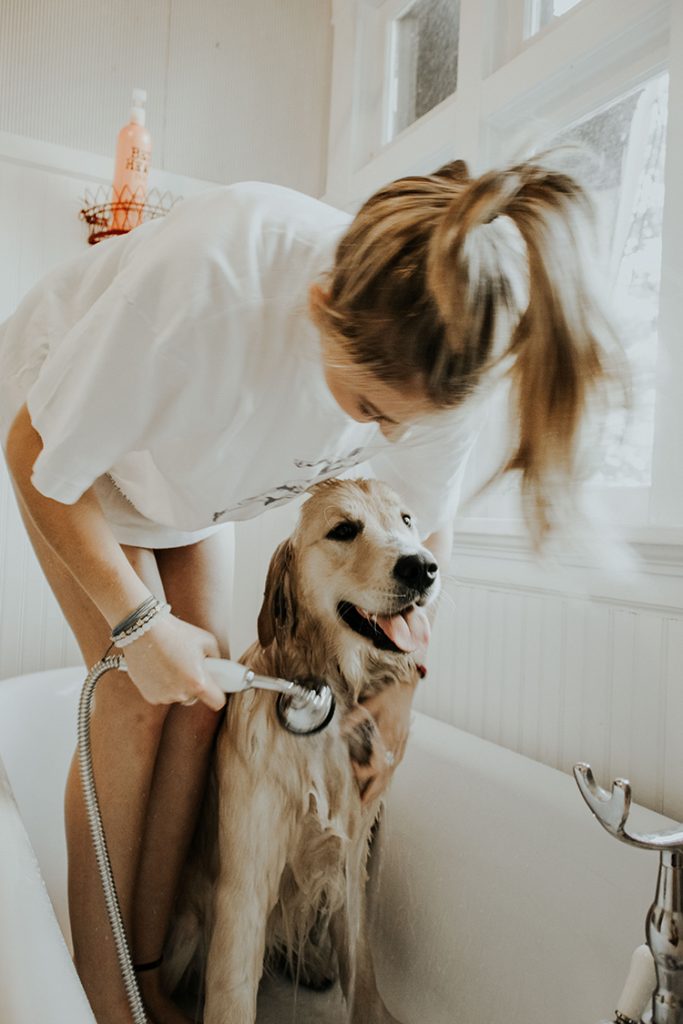
Tip: if your dog is very treat-orientated, a smear of peanut butter on the wall or side of the bath is often enough to keep them distracted while you wash them!
Always use a shampoo specially formulated for dogs. Just like people, dogs suffer from skin irritations and produce natural oils to protect their fur. Over-washing, or using a shampoo formulated for humans, can strip those natural oils and leave your pet with dry, flaking, and irritated skin.
Remember they have similar tolerances to hot and cold as we do. Your dog’s bathwater should be temperate so they don’t get burned or chilled. If you’re bathing your dog outside, check the hose in summer because the water inside may have heated up in the sun. If it’s cold out, consider using buckets of warm water to wash your dog.
Wash your dog by working the shampoo into a lather in their fur, always rubbing in the direction it grows. Use your fingers in a combing motion to get the suds down to your pet’s undercoat and make sure they’re really clean. Speak to your dog while you’re cleaning them, offering lots of praise so they know they’re doing well.
Rinse out the shampoo thoroughly, repeat with conditioner if desired, and during the final rinse-down work from the top down and firmly run your hand across their coat to push any excess water out.
After the bath
Have an absorbent towel on hand for the moment you’re done bathing your dog. Larger dogs will probably jump out of the bath themselves once they sense you’re done, and all dogs will want to shake off immediately. Holding the towel above—but not against—them will let them remove excess water while not spraying down your entire room.
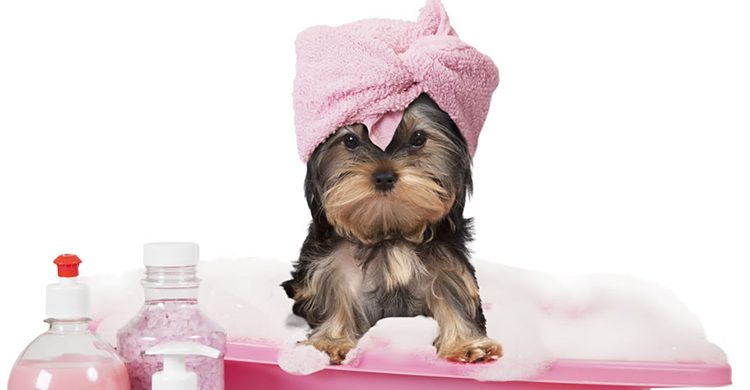
You’re unlikely to get your dog completely dry unless they have a very thin coat, but give them a good rub down with the towel to get as much excess water off as possible. If you’re bathing them inside, don’t be surprised if they find the nearest carpet and roll on it a few times!
Blow-drying your dog isn’t usually necessary. Most pets find hairdryers scary, and the hot air can burn or irritate their skin. Instead you can let them air-dry as long as it isn’t too cold. Finish up by giving them lots of pets and praise.
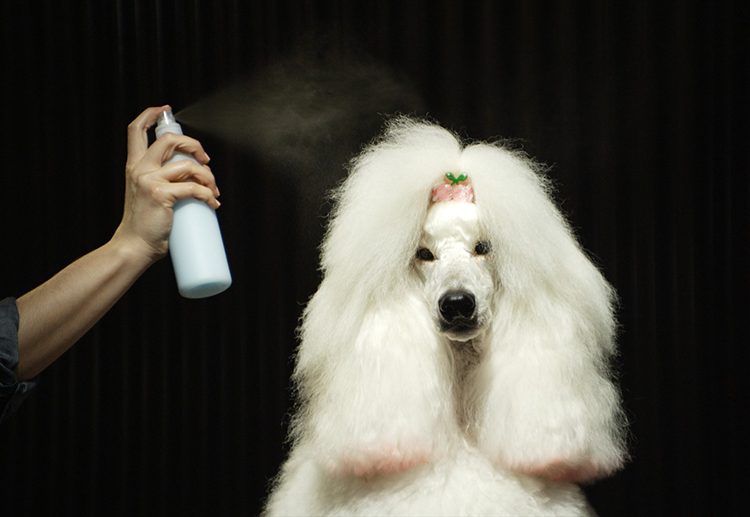
If your dog is shedding, brushing after a bath is a great way to get lots of loose hair out. Double-coated dogs such as Labradors and German shepherds can be brushed wet, but try to get other breeds as dry as possible first. The finer their hair, the dryer it should be before brushing to prevent creating more matts and tangles.
Training your pet to accept being groomed and washed can be a long, stressful process, but with consistent effort most animals will come around to being brushed and bathed. As a dog owner, it’s rewarding to know you’re doing the best for your pet’s health, and grooming can be a great bonding experience for you and your pupper. Keeping their coat healthy also helps you save time with home cleaning, as you can get most of their loose fur off them in one session, rather than having to vacuum it from your carpets!